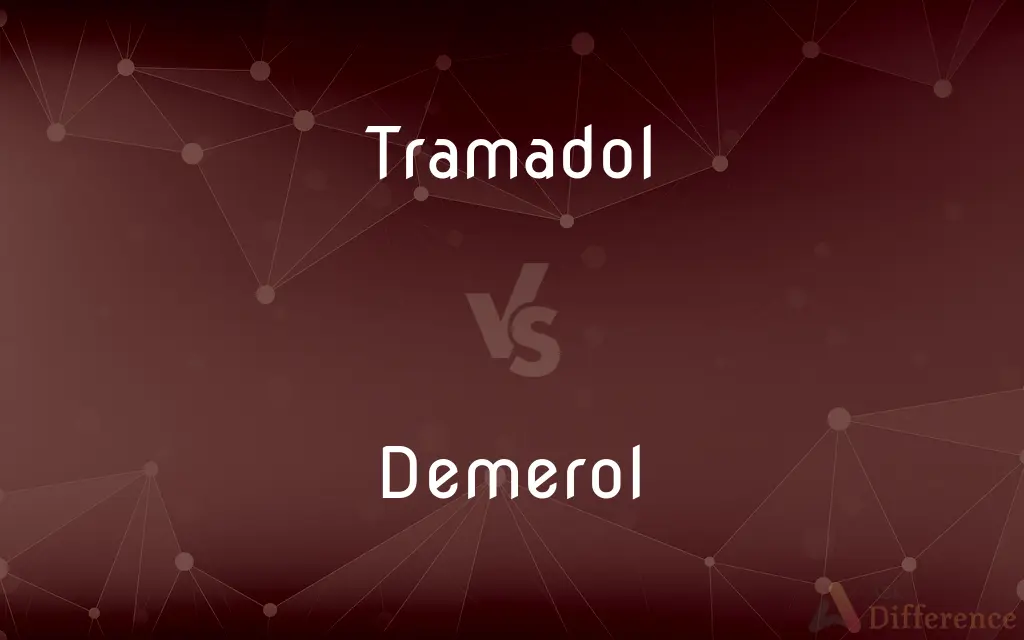Tramadol vs. Demerol — What's the Difference?
By Maham Liaqat & Urooj Arif — Updated on April 8, 2024
Tramadol is a synthetic opioid for moderate to severe pain, affecting serotonin and norepinephrine. Demerol (meperidine) is for short-term severe pain, with higher neurotoxicity and dependency risk.

Difference Between Tramadol and Demerol
Table of Contents
ADVERTISEMENT
Key Differences
Tramadol is often prescribed for chronic pain conditions due to its effectiveness in pain relief and a lower risk of dependence compared to other opioids. It works by binding to mu-opioid receptors and inhibiting the reuptake of serotonin and norepinephrine, which helps alter the body's perception of pain. Demerol, on the other hand, is preferred for acute episodes of severe pain, particularly in post-surgical settings or labor, due to its rapid onset and effectiveness. However, its use is limited by concerns over its potential to cause neurotoxicity, especially with prolonged use, and a higher potential for addiction and withdrawal symptoms.
The side effect profiles of Tramadol and Demerol also differ. Tramadol can cause nausea, dizziness, and seizures, particularly at high doses or when combined with other medications. Demerol's side effects include sweating, confusion, and, notably, a risk of serotonin syndrome when combined with other serotonergic drugs. This risk of serotonin syndrome is particularly concerning because it can be life-threatening, necessitating careful consideration when prescribing.
Tramadol's analgesic effect has a slower onset but is longer-lasting, making it suitable for chronic pain management. In contrast, Demerol acts quickly but has a shorter duration of action, which is why it is not typically chosen for long-term pain management. The distinct pharmacokinetics of these drugs underlines their suitability for different types of pain conditions.
In terms of dependency and regulatory status, Tramadol is classified as a Schedule IV controlled substance in the United States, reflecting its perceived lower risk of abuse and addiction. Demerol is a Schedule II drug, indicating a higher potential for abuse and dependence. This classification influences how these drugs are prescribed and monitored, with Demerol being subject to stricter regulations.
Despite these differences, both Tramadol and Demerol are important tools in the management of pain. Their use requires careful consideration of the patient's condition, potential side effects, and risk factors for dependence and abuse. The choice between them depends on the nature of the pain, patient history, and the desired balance between efficacy and safety.
ADVERTISEMENT
Comparison Chart
Primary Use
Moderate to severe chronic pain management
Short-term severe pain management
Mechanism of Action
Mu-opioid receptor agonist and inhibits reuptake of serotonin and norepinephrine
Mu-opioid receptor agonist
Onset of Action
Slower onset but longer-lasting effects
Rapid onset but short duration of action
Side Effects
Nausea, dizziness, seizures
Sweating, confusion, risk of serotonin syndrome
Risk of Dependency
Lower compared to other opioids
Higher potential for addiction and withdrawal
Regulatory Status
Schedule IV controlled substance
Schedule II controlled substance
Compare with Definitions
Tramadol
A synthetic opioid used for pain relief.
The doctor prescribed Tramadol to manage her chronic back pain.
Demerol
Carries a higher risk of neurotoxicity with long-term use.
Extended use of Demerol can lead to serious side effects, including neurotoxicity.
Tramadol
Acts on the central nervous system to alter pain perception.
Tramadol's dual mechanism provides effective pain management without high doses.
Demerol
Known for its rapid pain-relieving effects.
The quick action of Demerol makes it suitable for labor pain.
Tramadol
May cause seizures in susceptible individuals.
Patients with a history of seizures may need an alternative to Tramadol.
Demerol
Can cause serotonin syndrome if mixed with other serotonergic drugs.
Combining Demerol with certain antidepressants can be dangerous.
Tramadol
Used for both acute and chronic pain conditions.
Tramadol can effectively manage the pain from osteoarthritis.
Demerol
An opioid analgesic for severe pain, especially post-surgery.
Demerol was administered for immediate pain relief after her surgery.
Tramadol
Lower risk of addiction than other opioids.
Due to its Schedule IV status, Tramadol is considered safer for long-term use.
Demerol
A Schedule II drug indicating high potential for abuse.
Due to its addictive properties, Demerol is strictly controlled.
Tramadol
Tramadol, sold under the brand name Ultram among others, is an opioid pain medication used to treat moderate to moderately severe pain. When taken by mouth in an immediate-release formulation, the onset of pain relief usually begins within an hour.
Demerol
A synthetic narcotic drug (trade name Demerol) used to treat pain
Tramadol
A synthetic analgesic, C16H25NO2, used in its hydrochloride form to treat moderate to moderately severe pain. It is structurally similar to codeine and has both opioid and nonopioid effects.
Tramadol
(pharmaceutical drug) A synthetic opioid analgesic administered orally in the form of its hydrochloride C16H25NO2·HCl to treat moderate to severe pain.
Common Curiosities
Is there a risk of addiction with Tramadol?
Yes, while lower than other opioids, there is still a risk of addiction with Tramadol, especially with prolonged use or in individuals with a history of substance abuse.
Why is Tramadol preferred over Demerol for chronic pain?
Tramadol has a lower risk of dependency and is effective for long-term pain management due to its slower onset and longer-lasting effects.
What makes Tramadol unique among opioids?
Its dual mechanism of action, affecting both opioid receptors and neurotransmitter reuptake, makes it unique and effective for a broader range of pain types.
How are the side effects of Tramadol and Demerol managed?
Side effects are managed by adjusting dosages, monitoring patient responses closely, and avoiding interactions with other medications.
What should be considered when prescribing these opioids?
The patient's pain type, history of substance abuse, potential for side effects, and the specific characteristics of each drug should be considered.
Why is Demerol's use limited in medical practice?
Due to its short duration of action, high risk of dependency, and potential for serious side effects, including neurotoxicity, its use is limited to specific short-term applications.
Can Demerol be used for long-term pain management?
No, due to its high potential for addiction and risk of neurotoxicity, Demerol is not recommended for long-term use.
Can Tramadol cause serotonin syndrome?
Yes, though less commonly than Demerol, Tramadol can cause serotonin syndrome, especially when combined with other serotonergic medications.
How does the regulatory status of Tramadol and Demerol affect their prescription?
The stricter controls on Demerol reflect its higher abuse potential, influencing how and when it is prescribed compared to Tramadol.
What are the alternatives if a patient cannot take Tramadol or Demerol?
Alternatives may include non-opioid pain relievers, other opioids with a lower risk profile, or non-pharmacological pain management strategies.
Share Your Discovery

Previous Comparison
Checked vs. Checkered
Next Comparison
Leftover vs. BalanceAuthor Spotlight
Written by
Maham LiaqatCo-written by
Urooj ArifUrooj is a skilled content writer at Ask Difference, known for her exceptional ability to simplify complex topics into engaging and informative content. With a passion for research and a flair for clear, concise writing, she consistently delivers articles that resonate with our diverse audience.













































